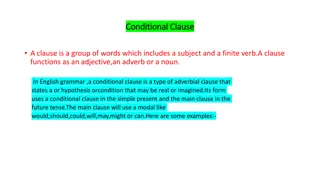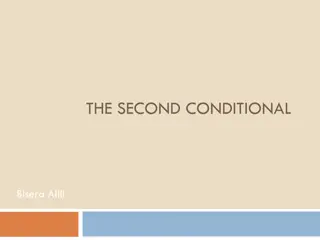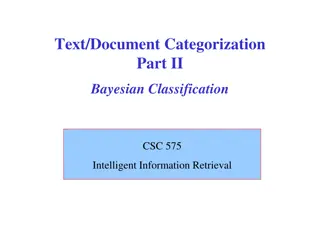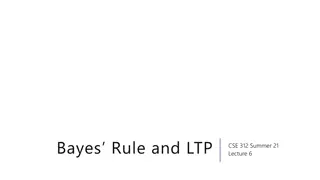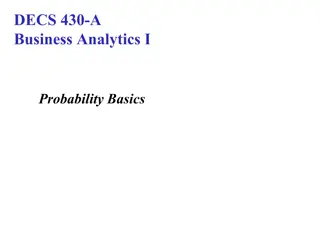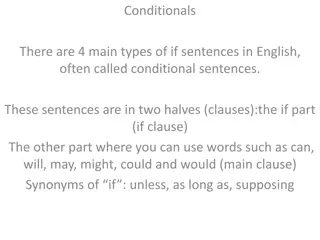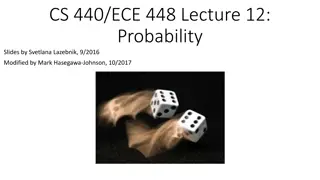Understanding Conditional Probability and Independence in Statistics
Conditional probability and independence are essential concepts in statistics. This lesson covers how to find and interpret conditional probabilities using two-way tables, calculate probabilities using the conditional probability formula, and determine the independence of events. Through examples like the Census at School survey, you will learn how to apply these concepts to real-world scenarios. Understanding conditional probability and independence is crucial for making informed decisions based on statistical data.
Download Presentation

Please find below an Image/Link to download the presentation.
The content on the website is provided AS IS for your information and personal use only. It may not be sold, licensed, or shared on other websites without obtaining consent from the author. Download presentation by click this link. If you encounter any issues during the download, it is possible that the publisher has removed the file from their server.
E N D
Presentation Transcript
Probability Lesson 4.4 Conditional Probability and Independence Statistics and Probability with Applications, 3rdEdition Starnes & Tabor Bedford Freeman Worth Publishers
Conditional Probability and Independence Learning Targets After this lesson, you should be able to: Find and interpret conditional probabilities using two-way tables. Use the conditional probability formula to calculate probabilities. Determine whether two events are independent. Statistics and Probability with Applications, 3rdEdition 2 2
Conditional Probability and Independence The probability of an event can change if we know that some other event has occurred. Conditional Probability The probability that one event happens given that another event is known to have happened is called a conditional probability. The conditional probability that event B happens given that event A has happened is denoted by P(B | A). Statistics and Probability with Applications, 3rdEdition 3 3
Happy, Healthy, Rich, or Famous? Happy, Healthy, Rich, or Famous? Conditional probabilities and two Conditional probabilities and two- -way tables PROBLEM: One question on the Census at School survey (http://www.amstat.org/censusatschool/index.cfm) asks students if they would prefer to be happy, healthy, rich or famous. Students may only choose one of these responses. The two-way table below summarizes the responses of 218 high school students from the United States by gender. way tables GENDER Female Male Total Happy 90 46 136 STATUS Healthy 20 13 33 Rich 10 31 41 Famous 0 8 8 Total 120 98 218 Suppose we randomly select one of these 218 students. Define events F: female, H: happy, and R: rich. Statistics and Probability with Applications, 3rd Edition 4 4
Happy, Healthy, Rich, or Famous? Happy, Healthy, Rich, or Famous? Conditional probabilities and two Conditional probabilities and two- -way tables way tables GENDER Female Male Total Happy 90 46 136 STATUS Healthy 20 13 33 Rich 10 31 41 Famous 0 8 8 Total 120 98 218 (a) Find P(H | F). Interpret this value in context. P(H | F) = P(happy | female) = 90/120 = 0.75 Given that the randomly chosen person is female, there is about a 75% chance that she prefers to be happy. (b) Given that the chosen person did not choose rich, what s the probability that this person is female? Write your answer as a probability statement using correct symbols for the events. P(female | not rich) = P(F | RC) = 136 33 8 + 90 20 0 + + + 110 177 = = 0.814 Statistics and Probability with Applications, 3rd Edition 5 5
Conditional Probability and Independence By exploring probabilities through a two-way table, we can determine a general formula for computing conditional probabilities. Calculating Conditional Probabilities To find the conditional probability P(A | B), use the formula Statistics and Probability with Applications, 3rd Edition 6 6
More dogs and cats? More dogs and cats? Calculating conditional probability Calculating conditional probability PROBLEM: In one large city, 40% of all households own a dog, 32% own a cat, and 18% own both. Suppose we randomly select a household and record which type of pet is owned by that household. Here is a Venn diagram showing the relevant events and probabilities. Statistics and Probability with Applications, 3rd Edition 7 7
More dogs and cats? More dogs and cats? Calculating conditional probability Calculating conditional probability What s the probability that a randomly selected resident who owns a cat also owns a dog? P(owns a dog | owns a cat) = ? ? ? =? ? ? ? ? ?.?? ?.?? + ?.?? = ?.???? = Statistics and Probability with Applications, 3rd Edition 8 8
Conditional Probability and Independence Suppose you toss a fair coin twice. Define events A: first toss is a head, and B: second toss is a head. We know that P(A) = 1/2 and P(B) = 1/2. What s P(B | A)? It s the conditional probability that the second toss is a head given that the first toss was a head. The coin has no memory, so P(B | A) = 1/2. What s P(B | AC)? It s the conditional probability that the second toss is a head given that the first toss was not a head. Getting a tail on the first toss does not change the probability of getting a head on the second toss, so P(B | AC) = 1/2. In this case, P(B | A) = P(B | AC) = P(B). Knowing whether or not the first toss was a head does not change the probability that the second toss is a head. We say that A and B are independent events. Statistics and Probability with Applications, 3rd Edition 9 9
Conditional Probability and Independence Independent Events A and B are independent events if knowing whether or not one event has occurred does not change the probability that the other event will happen. In other words, events A and B are independent if P(A | B) = P(A | BC) = P(A) and P(B | A) = P(B | AC) = P(B) Statistics and Probability with Applications, 3rd Edition 10 10
Is there a relationship between gender and allergies? Is there a relationship between gender and allergies? Checking for independence Checking for independence PROBLEM: Data on gender and allergies were obtained from a random sample of 227 students who responded to an online survey on the Census at School website. The data are summarized in the two- way table shown below. Gender Female Male Total Allergies 50 34 84 Allergies No 80 63 143 allergies Total 130 97 227 Statistics and Probability with Applications, 3rd Edition 11 11
Is there a relationship between gender and allergies? Is there a relationship between gender and allergies? Checking for independence Checking for independence Gender Female Male Total Allergies 50 34 84 Allergies No 80 63 143 allergies Total 130 97 227 Suppose we choose one of the students in the sample at random. Are the events female and allergies independent? Justify your answer. P(allergies | female) = 50/130 0.385 P(allergies | male) = 34/97 0.351 Because these probabilities are not equal, the events female and allergies are not independent. Knowing that the student is female increases the probability that the student has allergies. Statistics and Probability with Applications, 3rd Edition 12 12
LESSON APP 4.4 Who earns A s in college? Students at the University of New Hampshire received 10,000 course grades in a recent semester. The two-way table breaks down these grades by which school of the university taught the course. The schools are Liberal Arts, Engineering and Physical Sciences (EPS), and Health and Human Services. Choose a University of New Hampshire course grade at random. Consider the two events E: the grade comes from an EPS course, and L: the grade is lower than a B. 1. 2. Find P(L | E). Interpret this probability in context. Are events L and E independent? Justify your answer. Statistics and Probability with Applications, 3rd Edition 13 13
LESSON APP 4.4 Who earns A s in college? 1. Find P(L | E). Interpret this probability in context. 2. Are events L and E independent? Justify your answer. Statistics and Probability with Applications, 3rd Edition 14 14
Conditional Probability and Independence Learning Targets After this lesson, you should be able to: Find and interpret conditional probabilities using two-way tables. Use the conditional probability formula to calculate probabilities. Determine whether two events are independent. Statistics and Probability with Applications, 3rd Edition 15 15




